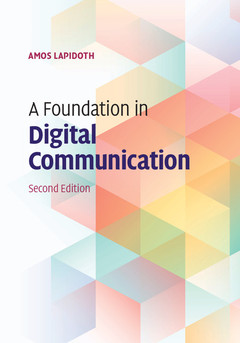Description
A Foundation in Digital Communication (2nd Ed., Revised edition)
Author: Lapidoth Amos
A fully updated introductory text that derives the key results of digital communication from first principles.
Language: English
Subject for A Foundation in Digital Communication:
Approximative price 106.56 €
In Print (Delivery period: 14 days).
Add to cart
Publication date: 02-2017
916 p. · 18.2x25.3 cm · Hardback
916 p. · 18.2x25.3 cm · Hardback
Description
/li>Contents
/li>Biography
/li>
Written in the intuitive yet rigorous style that readers of A Foundation in Digital Communication have come to expect, this second edition includes entirely new chapters on the radar problem (with Lyapunov's theorem) and intersymbol interference channels, new discussion of the baseband representation of passband noise, and a simpler, more geometric derivation of the optimal receiver for the additive white Gaussian noise channel. Other key topics covered include the definition of the power spectral density of nonstationary stochastic processes, the geometry of the space of energy-limited signals, the isometry properties of the Fourier transform, and complex sampling. Including over 500 homework problems and all the necessary mathematical background, this is the ideal text for one- or two-semester graduate courses on digital communications and courses on stochastic processes and detection theory. Solutions to problems and video lectures are available online.
1. Some essential notation; 2. Signals, integrals, and sets of measure zero; 3. The inner product; 4. The space L2 of energy-limited signals; 5. Convolutions and filters; 6. The frequency response of filters and bandlimited signals; 7. Passband signals and their representation; 8. Complete orthonormal systems and the sampling theorem; 9. Sampling real passband signals; 10. Mapping bits to waveforms; 11. Nyquist's criterion; 12. Stochastic processes: definition; 13. Stationary discrete-time stochastic processes; 14. Energy and power in PAM; 15. Operational power spectral density; 16. Quadrature amplitude modulation; 17. Complex random variables and processes; 18. Energy, power, and PSD in QAM; 19. The univariate Gaussian distribution; 20. Binary hypothesis testing; 21. Multi-hypothesis testing; 22. Sufficient statistics; 23. The multivariate Gaussian distribution; 24. Complex Gaussians and circular symmetry; 25. Continuous-time stochastic processes; 26. Detection in white Gaussian noise; 27. Noncoherent detection and nuisance parameters; 28. Detecting PAM and QAM signals in white Gaussian noise; 29. Linear binary block codes with antipodal signaling; 30. The radar problem; 31. A glimpse at discrete-time signal processing; 32. Intersymbol interference.
Amos Lapidoth is Professor of Information Theory at Eidgenössische Technische Hochschule Zürich, the Swiss Federal Institute of Technology, and a Fellow of the Institute of Electrical and Electronics Engineers. He received his PhD in Electrical Engineering from Stanford University, California and has held the positions of Assistant Professor and Associate Professor at the Massachusetts Institute of Technology.
© 2024 LAVOISIER S.A.S.




